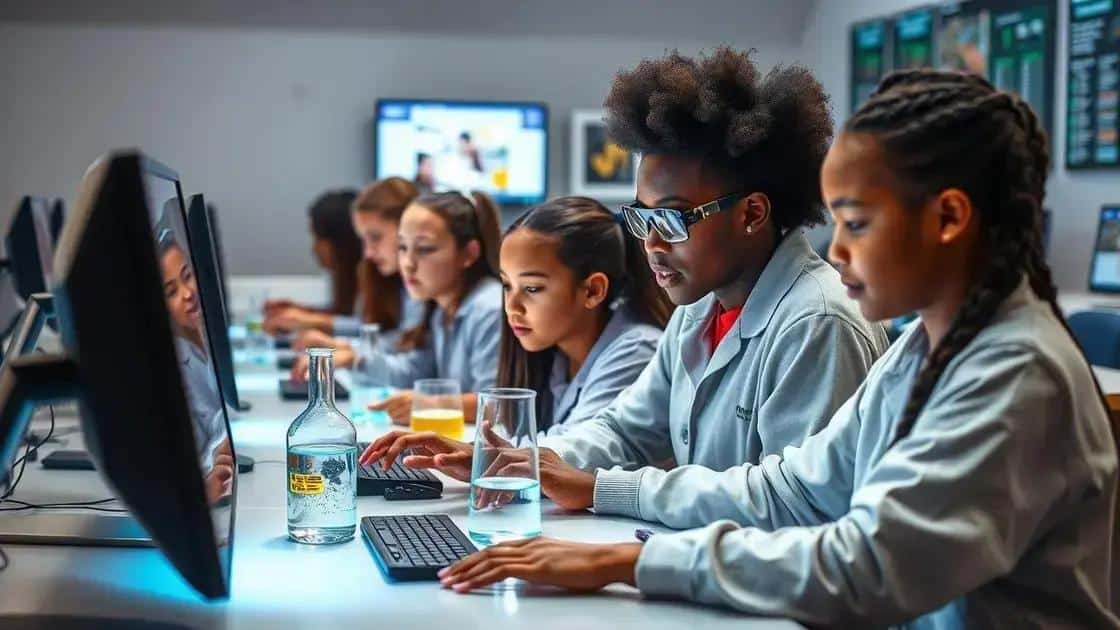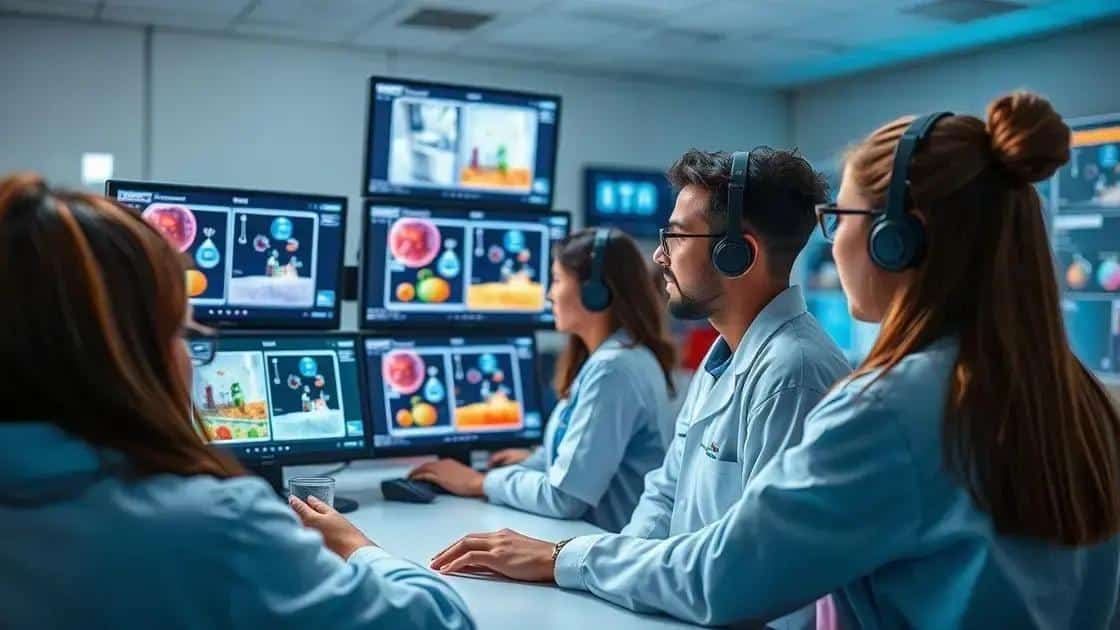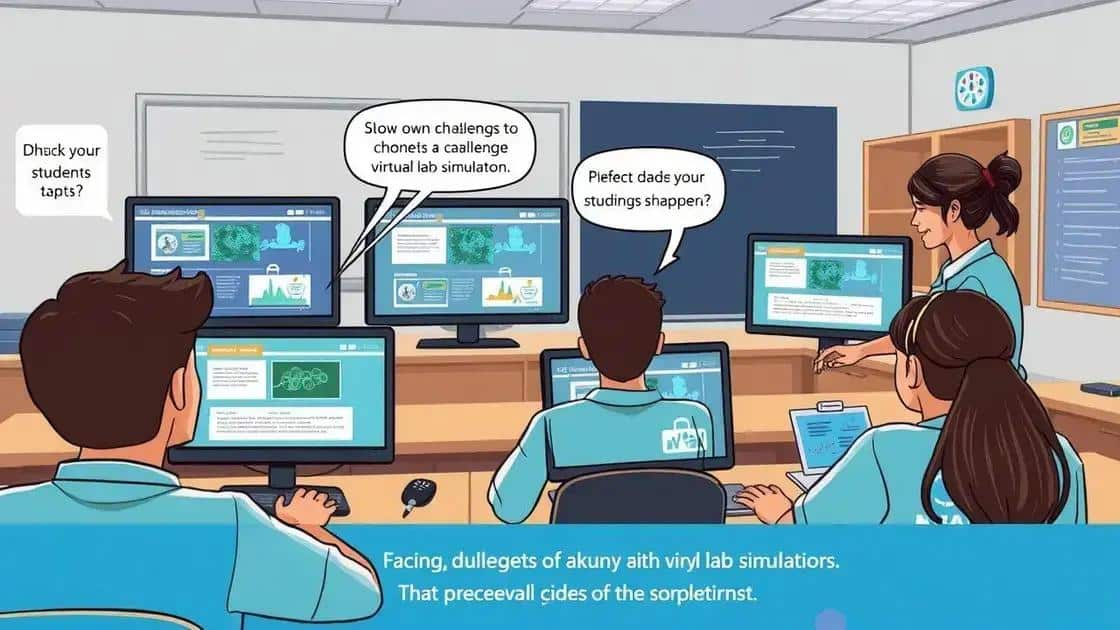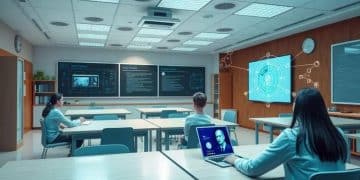Insights on virtual lab simulations for better learning

Virtual lab simulations enhance educational experiences by providing interactive, safe environments for students to conduct experiments, while addressing challenges like access and technical skills.
Insights on virtual lab simulations reveal how they can elevate the learning experience. Have you ever considered how these innovative tools make complex subjects more accessible and engaging for students? Let’s dive into the fascinating world of virtual labs.
Understanding virtual lab simulations
Understanding virtual lab simulations is crucial for teachers and students alike. These tools enable learners to conduct experiments in a safe environment, enhancing their grasp of complex concepts.
The significance of virtual lab simulations
Virtual lab simulations provide an interactive way for students to explore different scientific principles. By mimicking real-world lab settings, they engage students more effectively than traditional methods. Through these simulations, students can perform experiments at their own pace, allowing for deeper learning and exploration.
Key benefits of virtual lab simulations
- Accessibility: Students can access virtual labs from anywhere, ensuring no one misses out on learning.
- Cost-effective: Schools can save on materials and equipment that would otherwise be necessary for physical labs.
- Safe environment: Students can make mistakes without real-world consequences, encouraging experimentation and discovery.
- Immediate feedback: Many virtual labs provide instant results, helping students learn continuously.
Through engaging interfaces and user-friendly designs, students can manipulate variables and see outcomes in real time. This interaction not only keeps them focused but also helps in retaining information longer. Adopting virtual lab simulations fosters a more positive learning experience, where students feel empowered to explore and understand.
In summary, understanding virtual lab simulations opens up a world of possibilities in education. By integrating these innovative resources, educators can transform the learning landscape, making complex topics accessible and enjoyable for all students.
Benefits of virtual lab simulations in education

The benefits of virtual lab simulations in education are vast and impactful. These innovative tools not only enhance learning but also transform the teaching environment.
Increased engagement
Students often find traditional teaching methods less engaging. By incorporating virtual lab simulations, educators spark curiosity and enthusiasm. These interactive experiences excite students, making them more willing to participate and explore.
Personalized learning experiences
Virtual labs allow students to learn at their own pace. This personalized approach helps accommodate different learning styles. For example, a student who struggles with a concept can revisit the simulation until they grasp it fully.
- Flexibility: Students can choose the time and place to learn.
- Interactive feedback: Many simulations provide instant feedback, helping students correct mistakes.
- Diverse scenarios: Students can explore a range of experiments that would be impossible in a physical lab.
Moreover, virtual lab simulations often reduce costs associated with physical lab equipment. Schools can allocate funds to other vital areas while providing high-quality educational experiences. This efficiency also means that more students can access advanced learning technologies.
By integrating these simulations, educators foster critical thinking. Students analyze data and draw conclusions, mimicking real scientific inquiry. This practice prepares them for future academic or professional pursuits in science and technology.
Ultimately, the benefits of virtual lab simulations in education extend beyond just learning. They promote a safe and supportive environment that builds confidence. Students feel empowered to ask questions and experiment, leading to a richer educational journey.
How to effectively implement virtual lab simulations
Implementing virtual lab simulations effectively can significantly enhance learning outcomes. To start, it is important to select tools that align with the curriculum. This ensures that the virtual labs complement the lessons being taught in class.
Choosing the right platform
Different virtual lab platforms offer various features. It’s vital to choose one that best engages students and provides a variety of experiments. Considerations include ease of use, accessibility, and the range of simulations available. Seeking input from fellow educators can also help in making informed decisions.
Training educators and students
Once a platform is selected, the next step is training. Both educators and students should understand how to navigate the virtual lab. This training can be a simple workshop, introducing key features and functionalities. When everyone is comfortable with the technology, the learning experience becomes smoother.
- Provide resources: Offer guides or videos that explain how to use the platform.
- Encourage collaboration: Group students to explore together and share insights.
- Use real-world examples: Relate simulations to practical scenarios they may face.
After training, it’s essential to integrate virtual labs into regular lessons. Start by assigning simple simulations that complement classroom discussions. As students become more familiar, challenges can increase in complexity. This gradual progression helps maintain their interest and motivation.
Regular feedback from students is also important during the implementation phase. Ask them which aspects they enjoy or find challenging. This insight can guide adjustments to improve both teaching strategies and student engagement. Data from assessments can help track progress and make necessary changes.
In conclusion, to successfully implement virtual lab simulations, thoughtful planning, training, and ongoing feedback are key. By ensuring a supportive environment for both educators and students, the benefits of these innovative tools can be fully realized.
Challenges faced with virtual lab simulations

Implementing virtual lab simulations in education presents various challenges that educators must navigate. Understanding these challenges is crucial for making the most of this technology.
Technical difficulties
One common issue is the technical skills required to operate these simulations effectively. Not all students or teachers are familiar with technology. This lack of experience can lead to frustration and hinder the learning process.
Access and equity
Another significant challenge is access to technology. Not every student has the necessary devices or reliable internet connections at home. This digital divide can result in unequal learning opportunities among students.
- Resource allocation: Schools must invest in hardware and software, which can be costly.
- Training demands: Ongoing training for both students and teachers is essential but requires time and effort.
- Support systems: Adequate IT support must be in place to help resolve technical issues quickly.
Furthermore, some students may experience motion sickness or discomfort from prolonged screen time. Balancing screen-based learning with other educational methods is crucial to avoid such problems.
There’s also the question of curriculum alignment. Not all virtual lab simulations align with existing curricula, making it difficult for educators to integrate them seamlessly into their lesson plans. This lack of compatibility can lead to confusion and mismatched objectives.
In the face of these challenges, planning and adaptability are key. Educators need to be prepared to troubleshoot technical issues and find creative solutions to meet all students’ needs. Addressing the barriers to successful implementation is vital for maximizing the potential of virtual lab simulations.
FAQ – Virtual Lab Simulations in Education
What are virtual lab simulations?
Virtual lab simulations are interactive online platforms that allow students to conduct experiments and learn scientific concepts in a virtual setting.
What benefits do virtual lab simulations offer?
They enhance engagement, provide personalized learning experiences, and allow for experimentation without the risks or costs associated with physical labs.
What challenges might educators face when implementing virtual labs?
Challenges include technical difficulties, access to technology, ensuring curriculum alignment, and the need for training for both teachers and students.
How can students get support while using virtual lab simulations?
Students can seek help from teachers, utilize online resources, and collaborate with peers to enhance their understanding and address any issues they encounter.





